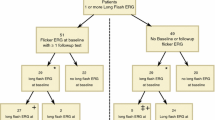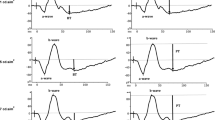Abstract
Purpose: Vigabatrin (γ-vinyl-GABA) is an antiepileptic drug successful in the management of infantile spasms. Photopic ERGs were tested in children followed longitudinally before and during vigabatrin treatment. Methods: Subjects were 26 infants (age range 1.5–24 months, median 7.6 months) on vigabatrin treatment who had been tested on multiple visits (two to four visits; mean, three visits). Eighteen of these were assessed initially before starting vigabatrin therapy and eight were assessed within 1 week of initiation of the drug. ERGs were recorded at 6-month intervals. Standard ISCEV protocol with Burian-Allen bipolar contact-lens electrodes (standard flash 2.0 cd.s/m2) was used. Although ISCEV standards were followed, a higher flash intensity (set at 3.6 cd.s/m2) was chosen for single-flash cone assessment to provide a better definition of OPs. Photopic OPs were divided into categories of early OPs and late OP (OP4). Responses were compared with age corrected limits extrapolated from our lab control database. Results: Results showed differential effects of vigabatrin on the summed early OP amplitudes versus the late OP (OP4) and cone b-wave amplitude. The early OPs showed significant decrease (p=0.0005, repeated measures analysis of variance) after 6 months and remained decreased for the duration of treatment. There was no significant change seen in the late OP. The cone b-wave amplitude showed initial increase (p=0.04) after 6 months, followed by a decrease after 18 months; a trend similar to that of the late OP. Conclusion: Early photopic OPs were disrupted more than the late OP, suggesting relative deficit in the ON (depolarizing) retinal pathways.
Similar content being viewed by others
References
Daneshvar H, Racette L, Coupland SG, Kertes PJ, Guberman A Zackon D. Symptomatic and asymptomatic visual loss in patients taking vigabatrin. Ophthalmology1999; 106(9): 1792–8.
Krauss GL, Johnson MA Miller NR. Vigabatrin-associated retinal cone system dysfunction: electroretinogram and ophthalmologic findings [see comments]. Neurology1998; 50(3): 614–8.
Miller NR, Johnson MA, Paul SR, Girkin CA, Perry JD, Endres M, Krauss GL. Visual dysfunction in patients receiving vigabatrin: clinical and electrophysiologic findings. Neurology 1999; 53(9): 2082–7.
Harding, GFA. Electrophysiological methods for assessing field losses associated with Vigabatrin. In International Society for Clinical Electrophysiology of Vision XXXVIII Symposium. 2000. Sydney, Australia.
Westall CA, Logan WJ, Smith K, Buncic JR, Panton CM, Abdolell M. The Hospital for Sick Children, Toronto, Longitudinal ERG studyof children on vigabatrin. Doc Ophthalmol 2002; 104(2):133–49.
Granit RL, Munsterhjelm A. The electrical response of dark adapted frog's eye to monochromatic stimuli. J Physiol 1937; 88: 436–58.
Heckenlively JR, Arden GB eds. Principles and Practice of Clinical Electrophysiologyof Vision. 1991, St Louis, MO: MosbyYear Book, Inc.
Ogden TE. The oscillatory waves of the primate electroretinogram. Vision Res 1973; 13(6): 1059–74.
Wachtmeister L, Dowling JE. The oscillatory potentials of the mudpuppyretina. Invest Ophthalmol Vis Sci 1978; 17(12): 1176–88.
Yanagida T, Koshimizu M, Kawasaki K, Yonemura D. Microelectrode depth studyof the electroretinographic oscillatory potentials in the frog retina. Doc Ophthalmol 1987; 67(4): 355–61.
Lachapelle P, Benoit J. Interpretation of the filtered 100-to 1000-Hz electroretinogram. Doc Ophthalmol 1994; 86(1): 33–46.
Westall CA, Panton CM, Levin AV. Time course for maturation of electroretinogram response, from infancy to adulthood. Doc Ophthalmol 1999; 96: 355–79.
Miller RF, Dacheux RF, Frumkes TE. Amacrine cells in Necturus retina: evidence for independent gamma-aminobutyric acid-and glycine-releasing neurons. Science 1977; 198(4318): 748–50.
Korol S, Leuenberger PM, Englert U, Babel J. In vivo effects of glycine on retinal ultrastructure and averaged electroretinogram. Brain Res 1975; 97(2): 235–51.
Wachtmeister L. Further studies on the chemical sensitivity of the oscillatorypotentials of the electroretinogram (ERG) 1. GABAand glycine antagonists. Acta Ophthalmol 1980; 58: 712–25.
Wachtmeister L. Oscillatory potentials in the retina: what do they reveal. Prog Retin Eye Res 1998; 17(4): 485–521.
Popova E, Penchev A. GABAergic control on the intensity-response function of the ERG waves under different background illumination. Biomed Biochim Acta 1990; 49(10): 1005–13.
Stockton RA, Slaughter,MM. B-wave of the electroretinogram. A reflection of ON bipolar cell activity. J Gen Physiol 1989; 93(1):101–22.
Neal MJ, Shah MA. Development of tolerance to the effects of vigabatrin (gamma-vinyl-GABA) on GABA release from rat cerebral cortex, spinal cord and retina. Br J Pharmacol 1990; 100(2): 324–8.
Graham LT. Intraretinal distribution of GABA content and GAD activity. Brain Res 1972; 36(2): 476–9.
Westall CA, Nobile R, Morong S, Buncic JR, Logan WJ, Panton CM. Changes in the electroretinogram resulting from discontinuation of vigabatrin in children. Doc Ophthalmol 2003; 107: 299–309.
Kondo M, Sieving PA. Post-photoreceptoral activitydominates primate photopic 32-Hz ERG for sine-, square-, and pulsed stimuli. Invest Ophthalmol Vis Sci 2002; 43(7): 2500–7.
Bush RA, Sieving PA. Inner retinal contributions to the primate photopic fast flicker electroretinogram. J Opt Soc Am A 1996; 13(3): 557–65.
Koulen P, Malitschek B, Kuhn R, Bettler B, Wassle H, Brandstatter JH. Presynaptic and postsynaptic localization of GABA(B) receptors in neurons of the rat retina. Eur J Neurosci 1998; 10(4): 1446–56.
Perez MT, Davanger S. Distribution of GABA immunoreactivity in kainic acid-treated rabbit retina. Exp Brain Res 1994; 100(2): 227–38.
Davson H. Transmitters in the retina. In Physiology of the eye. London: MacMillan 1990; 343–52.
Qian H, Dowling JE. Novel GABA responses from rod-driven retinal horizontal cells. Nature 1993; 361(6408): 162–4.
Kapousta-Bruneau. GABA a andGABA c receptor antagonists have opposite effects on the B-wave of ERG in rat retina. IOVS 1998; 39 (Suppl): S980.
Author information
Authors and Affiliations
Rights and permissions
About this article
Cite this article
Morong, S., Westall, C.A., Nobile, R. et al. Longitudinal changes in photopic OPs occurring with vigabatrin treatment. Doc Ophthalmol 107, 289–297 (2003). https://doi.org/10.1023/B:DOOP.0000005338.51554.e3
Issue Date:
DOI: https://doi.org/10.1023/B:DOOP.0000005338.51554.e3




